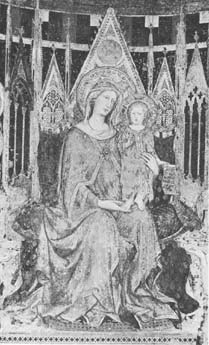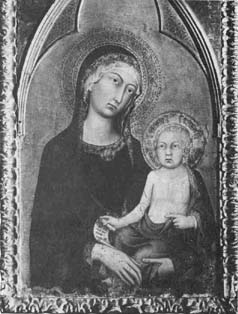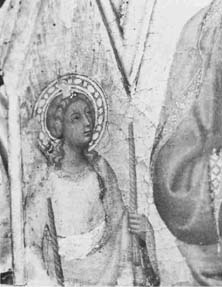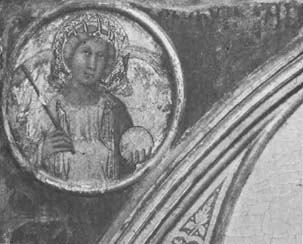
Annual Bulletin 3, 1979-1980
Home
Français
Introduction
History
Annual Index
Author &
Subject
Credits
Contact






Simone
Martini's St Catherine of Alexandria:
An Orvietan Altarpiece and the
Mystical Theology of St Bonaventure
by Joel Brink
Pages 1
| 2 | 3
| 4
| 5
| 6
| 7
| 8
Judging from the carpentry construction of Simone's
well-preserved altarpiece at Pisa (fig. 10), it is probable that the
compartments of the Orvietan triptych were unified structurally by four
continuous pier-shafts springing from the top of the base frame and attaching
to the edges of the support between each of the compartments. The lateral shafts would have established the side frames of the
altarpiece, and
the colonnettes would have been inserted next to these vertical elements
much as they are arranged in the Pisa polyptych and in the throne of the
Palazzo Pubblico Maestà (fig. 11). The high Gothic style
and lucidity that Simone Martini introduced to Tuscan altarpiece design
in the early Trecento is heralded in the structure of this magnificent
gilded throne. The elegant architecture of the Virgin's heavenly throne
is reproduced in the carpentry of the Pisa polyptych, and surely must
have characterized the general format of the master's altar paintings in Orvieto. This certainly applies to the dismantled polyptych in
Boston, (13)
which has lost its original frame, as well as to the Dominican altarpiece
in the Orvieto cathedral museum.
The feature of the reconstructed triptych (fig.
9) that distinguishes it from other altarpieces of the period is the new
pinnacle shape and its increased size and importance relative to the arcaded
field below. It is feasible that this arrangement was dictated by
the programmatic requirements of the Franciscan patrons, hence it is
the inconographical problems posed by the painting that must be considered
next.
Moving from the carpentry of the altarpiece to its iconography, one is immediately struck by the rich though
virtually
unexplored imagery of the central compartment in Orvieto. In no
altar painting by Simone Martini are we presented with such a dogmatic,
teaching type of Christ-child (fig. 12). Enthroned in his mother's arms,
the young Christ looks intently at the viewer, pointing rather emphatically
to a scroll with text. As if to say, "Behold these words, " Christ appears
to initiate a program of meaning which extends from the text into the upper
levels of the painting. The scripture inscribed on the scroll is from the
Gospel of St John (XIV:6) which records Christ's famous response
to the question of the Apostle Thomas during the last discourse. Thomas
asks, "Lord, we don't know where you are going. So how can we know the
way?" Christ answers, EGO SOM VIA VERITAS ET VITA, ("I am the way, the
truth, and the life"). With his serious expression and pointing finger
the Child Jesus would appear to be stressing his mission to mankind: that
he is the only avenue of salvation and hence the only way to the Father
in heaven. (14)
The iconography is equally interesting in the upper panels
(fig. 4). Above the cornice in the pinnacle appears the Redeemer, with
one hand raised in benediction and the other holding a closed book. In
the smaller gabled fields are two angels each bearing specific attributes.
On the left the angel, who is turning toward the Redeemer, is holding two
burning candles (fig. 13), while the angel opposite is poised frontally,
crowned with the laurel, and is displaying an open book with text (fig.
14). Uniting the upper and lower pictorial zones are two roundels with
identical angels (figs 15 & 16): both hold a staff and golden orb,
and an open, draped throne is placed before them. While each of these angels
is represented with two pairs of wings, those above in the pinnacle appear
to have three pairs, that on the left luminous and faintly visible, and
on the right accented clearly against the gold ground with blue-grey.
Similarly, the right-side angel in the pinnacle wears a type of liturgical
vestment cool-blue in coloration, while that opposite is depicted with
flowing drapery pink and warm in quality. The angels are each identified
by partially obscured inscriptions painted in black letters: below the
angels in the two roundels is inscribed TRONE (Throne), and just
below the cornice on the left is written - RAP-YM (Seraphim) with CERUB-M
(Cherubim) included below the angel with the open book.
Between these identifications just below the Redeemer is inscribed ALPH- &
O (Alpha and Omega) from the Book of Revelation. (15)
What is particularly unique about this arrangement of angels
is that the Thrones, Cherubim and Seraphim, which comprise the highest
order of the tri-level celestial hierarchy, were rarely if ever presented
together in this manner in contemporary Central Italian altarpieces. The
fact that they are so meticulously distinguished from one another in pose,
color, and attribute, and even identified by inscriptions, points inevitably
to a specific program of religious dogma which probably included the whole
three-fold angelic hierarchy in the original work of art. In this iconographical arrangement (fig. 17), the
two lower choirs of an gels would have comprised the lost roundels
and pinnacles of the side compartments. It is feasible that the
first order including the Angels, Archangels and Principalities was situated above the Ottawa
St Catherine of
Alexandria, (16) and the intermediate order
- the Powers, Virtues, and Dominations,
-was included above the unidentified saint on the right of the altarpiece.
The primary source for all the medieval scholastics on
the subject of the angels was the De Coelesti Hierarchia (The Celestial
Hierarchy) written by Dionysius the Pseudo-Areopagite about 500 A. D. (17)
Scotus Eriugena compiled a Latin translation of the work from the Greek
in the ninth century, and this became one of the principal sources from
which the theologians of the Middle Ages obtained a knowledge of the man
's mystical doctrines. The Dionysian
three-fold angelic structure derived from the idea that the further the
angels were removed from their source in God the less intense was their
love and knowledge of the Father. Hence the degree of illumination was
not identical for each triad in the hierarchy: the highest triad of angels
received its light directly from God and transmitted it, more fragmented,
to the intermediate order which in turn passed it, still more diffused,
to the lowest level of the hierarchy. The Dionysian schema is summarized
beautifully by Dante in the twenty-eighth Canto of Paradiso, where,
gazing into the eyes of Beatrice, he beholds the light of God encircled
by nine radiant rings which Beatrice identifies as the three hierarchies
or the nine orders of angels.
And all these orders upwards gaze with awe,
As Downwards each prevails upon the rest,
Whence all are drawn to God and to Him draw.
When Dionysius with ardent zest
Pondered these orders of angelic bliss,
His named them in this way, the true and best. (18)
Next Page | Dionysius
and scholastics
1
| 2 | 3
| 4
| 5
| 6
| 7
| 8
Annual Index | Author & Subject | Credits | Contact
This digital collection
was produced under contract to Canada's Digital Collections program,
Industry Canada.
"Digital
Collections Program, Copyright
© National Gallery of
Canada 2001"